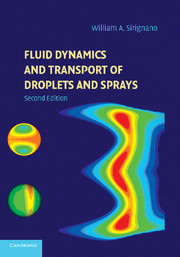Book contents
- Frontmatter
- Contents
- Preface
- Nomenclature
- 1 Introduction
- 2 Isolated Spherically Symmetric Droplet Vaporization and Heating
- 3 Convective Droplet Vaporization, Heating, and Acceleration
- 4 Multicomponent-Liquid Droplets
- 5 Droplet Behavior under Near-Critical, Transcritical, and Supercritical Conditions
- 6 Droplet Arrays and Groups
- 7 Spray Equations
- 8 Computational Issues
- 9 Spray Applications
- 10 Spray Interactions with Turbulence and Vortical Structures
- 11 Film Vaporization
- 12 Stability of Liquid Streams
- Appendix A The Field Equations
- Appendix B Conserved Scalars
- Appendix C Droplet-Model Summary
- Bibliography
- Index
10 - Spray Interactions with Turbulence and Vortical Structures
Published online by Cambridge University Press: 05 June 2012
- Frontmatter
- Contents
- Preface
- Nomenclature
- 1 Introduction
- 2 Isolated Spherically Symmetric Droplet Vaporization and Heating
- 3 Convective Droplet Vaporization, Heating, and Acceleration
- 4 Multicomponent-Liquid Droplets
- 5 Droplet Behavior under Near-Critical, Transcritical, and Supercritical Conditions
- 6 Droplet Arrays and Groups
- 7 Spray Equations
- 8 Computational Issues
- 9 Spray Applications
- 10 Spray Interactions with Turbulence and Vortical Structures
- 11 Film Vaporization
- 12 Stability of Liquid Streams
- Appendix A The Field Equations
- Appendix B Conserved Scalars
- Appendix C Droplet-Model Summary
- Bibliography
- Index
Summary
The interactions of a spray with a turbulent gas flow is important in many applications (e.g., most power and propulsion applications). Two general types of studies exist. In one type, the global and statistical properties associated with a cloud or spray within a turbulent field are considered. In the other type, detailed attention is given to how individual particles behave in a turbulent or vortical field. Some studies consider both perspectives. Most of the research work in the field has been performed on the former type of study. Faeth (1987), Crowe et al. (1988), and Crowe et al. (1996) give helpful reviews of this type of research.
The interactive turbulent fields can be separated into homogeneous turbulent fields and free-shear flows (e.g., jets and mixing layers). In some theoretical studies, two-dimensional vortical structures interacting with a spray have been examined. Most of the studies deal with situations in which the contribution of the spray to the generation of the turbulence field is secondary, that is, there is a forced gas flow whose mass flux and kinetic-energy flux substantially exceed the flux values for the liquid component of the dilute flow. The turbulent kinetic-energy flux of the gas flow is much less than the mean kinetic-energy flux of the gas flow and is comparable to the mean kinetic energy of the liquid flow. Therefore the turbulent field is much more likely in this situation to receive kinetic energy transferred from the mean gas flow than kinetic energy transferred from the mean liquid flow.
- Type
- Chapter
- Information
- Fluid Dynamics and Transport of Droplets and Sprays , pp. 314 - 339Publisher: Cambridge University PressPrint publication year: 2010
- 1
- Cited by



